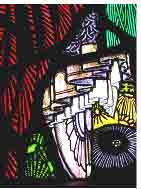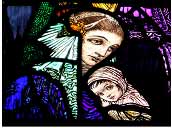Harry Clarke was recognised for his artistic genius and achieved great success during his own lifetime, yet he often gets pigeonholed into various modes of artistic expression. Clarke however, was not merely a symbolist, a revivalist, an illustrator, or a stained glass artist; he was all of these but also much more complex and interesting than it may at first seem.
Harry Clarke was born in Dublin on St Patrick’s Day in 1889. His mother, Brigid MacGonigle, encouraged the young Harry’s artistic sensitivities whilst his father, Joshua Clarke, ran a stained glass business which was to prove hugely influential to Harry’s artistic career. After his father’s death in 1921, Clarke took over the stained glass studios and produced highly sought after stained glass, as W.B. Yeats declared in 1924, “now the acknowledged best glass in the world is made by his son Harry Clarke”1. Clarke also dabbled in textile design, though, with the exception of his stained glass, he is most renowned for his wonderful illustrations. Before his death in 1931, Clarke produced a phenomenal cache of illustrations, the most powerful of which are those in black and white. Clarke’s illustrated books are collectibles, a testament to recognition of artistic genius. If Clarke was such a revolutionary figure in Ireland’s art circles, then it must be questioned why there is so little written on him. A few articles have been written on Clarke’s stained glass windows, but these are generally short and very non-specific. The main emphasis usually focuses on the visual beauty of Clarke’s work, rather than the content. A more insightful and useful investigation lies in the unexplored area of Clarke’s treatment of women, more specifically the iconography of femininity, within his oeuvre.
Clarke was working artistically at a time of great social and political upheaval in regards to the changing role of women, not only in Ireland, but also, in a broader sense, Europe. Societal changes saw the patriarchal balance of power disrupted by changing attitudes towards women and huge changes were seen in all aspects of culture. The new ‘modern woman’ was educated, independent, passionate, full of zest for life, and strove for her political voice to be heard and acknowledged. As was observed at the time, these modern women “have an amazing combination of wisdom and youthfulness, of humour and ability, and innocence and self-reliance, which absolutely belies everything you will read in the story-books or any other description of womankind”2. This new attitude towards women was reflected in visual and literary terms of that time. Throughout history what has been termed the ‘iconography of woman’ has portrayed class, social standing, and more importantly how women were viewed in society, and may be seen through an analysis of Clarke’s work.
The iconography in Clarke’s work can be seen as a poetic symbolism of femininity. The trappings of femininity, in terms of styles of dress and costume, attest to the changes in the role of women in society as represented by Clarke.
One indicator of feminine iconography can be seen in the clothing and costume of women. Fashion and frivolity has been seen to convey the materialism and vanity of the feminine sex almost exclusively3. The notion of costume locates clothing within the contexts of fantasy, mythology and fairy tale. Artists have often used costume to masquerade beauty as mythology. The changing fashions in women’s clothing at the turn of the twentieth century can be seen to reflect deeper transformations in the contemporary mindset. The emergence of the cinema allowed images of modern, stylish women to be consumed on a worldwide basis. Whilst costume allowed Clarke to invest a sense of the dramatic and the exotic in his work, his work can also be seen to reflect the contemporary fashions of woman.
A glance at the costumes in the Presentation Chapel windows in Dingle from 1924 gives an impression of a typical style of clothing traditionally used in religious imagery. However, a closer look reveals Clarke’s influences from the ballet, theatre and exotic fabrics.

Clarke attended the Ballet Russes season in London in 1919, and took particular delight in the extravagant costumes4. It must have had a lasting effect on Clarke’s imagination for he depicts ballet shoes on one angel in The Baptism window in 1924. In one section of The Nativity window, Clarke collects other souvenirs from the ballet with his inclusion of the two gem-encrusted, elaborate crowns and the unusual green costume shoes. Women’s headdresses are one of the most traditional details of Russian costume.

In a detail of the Suffer Little Children window (above left), the delicate design on the mother’s head-dress can be seen as a kokoshnik, a Russian headdress which was embroidered with strings of pearls and delicate threads5. The sumptuous design on the fabric of the clothing (right) is influenced by the European taste for oriental style bold patterns, which was influenced in part by the exotic costumes designed by Leon Bakst6.
With women’s emancipation came a call for a new image for woman. In the 1920s new simplified designs for clothing placed emphasis on the beauty of the functionality and purity of design7. Unlike the Victorian style, which accentuated women’s breasts, narrow waist and rounded derriere, the new style in women’s fashion emphasised a boyish frame with straight, clean cut lines and can be seen in many of Clarke’s illustrations and poster designs. Clarke was an avid fan of the theatre, cinema and the dramatic. He often designed posters for plays, the theatre, and for the Dublin Drama League which was set up in 19188. Clarke designed many posters for plays written by his close friend and playwright, Lennox Robinson. One poster in particular displays Clarke’s astute eye for costume design and was used to promote Robinson’s production of Pirandello’s The Games as he played it, in 19279. Clarke presents the ultimate 1920s woman. The elegant figure models cropped hair and sports contemporary style clothing, which emphasises her svelte androgynous frame. The emergence of the first screen flappers in the early 1920s and the influence of Hollywood cinema in Clarke’s art can undoubtedly be traced in this illustration. The figure’s dark, severe bob is reminiscent of one of the first flappers to emerge from Hollywood, actress Colleen Moore. The style of the flapper was more an expression of youth than of boyishness, and embodied a more sexually aware attitude10. Clarke’s work shows that, as an artist, he closely followed the trappings of femininity, from the fantastical to the ultra modern.